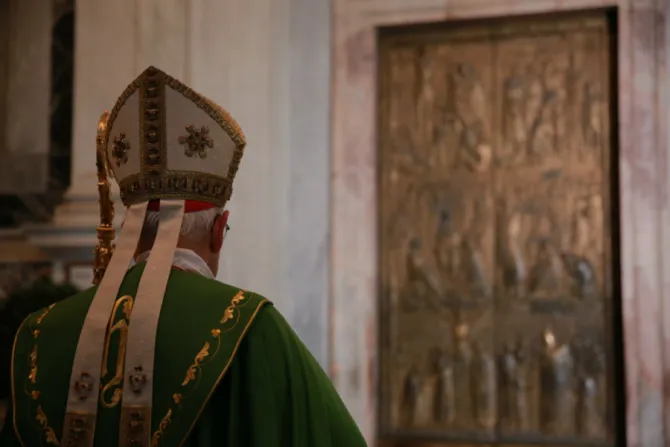Vatican City, Nov 13, 2016 / 13:09 pm
As Holy Doors close in churches and basilicas around the world, including in Rome, it is estimated that over 20 million people participated in the Church's Jubilee Year of Mercy at the Vatican – and a billion people may have participated in churches worldwide.
According to Msgr. Rino Fisichella, President of the Pontifical Council for the Promotion of the New Evangelization, it is estimated that 20.4 million people attended Year of Mercy events at the Vatican over the course of this year.
The Pontifical Council for the Promotion of the New Evangelization was in charge of putting Pope Francis' vision for the Year of Mercy into practice – both in the Vatican and abroad.
As the year comes to a close, the Holy Doors at three basilicas in Rome – St. Paul Outside the Walls, St. John Lateran and St. Mary Major – were closed during special Masses held Nov. 13. The Holy Doors at churches and basilicas around the world are also closing the same day.
The year will officially end on Nov. 20, the Solemnity of Christ the King, when Pope Francis will close the Holy Door at St. Peter's Basilica. It was opened on Dec. 8, 2015, the Solemnity of the Immaculate Conception.
The opening of the door is meant to symbolically illustrate the idea that the Church's faithful are offered an "extraordinary path" toward salvation during the time of Jubilee. Pilgrims who walked through the Holy Door were able to receive a plenary indulgence under the usual conditions.
In his homily for the Mass at St. John Lateran, Cardinal Agostino Vallini spoke about how the Holy Door, just closed, was a visible sign of the Jubilee of Mercy, a year where we learned "once again" that the fate of the world is not in the hands of men, "but in the mercy of God."
"What has it taught us, the meditation of God's mercy in this year?" he asked. "First of all that mercy is not a sign of weakness or surrender," but the "strong, magnanimous," radiation of the loving omnipotence of the Father, who "heals our weaknesses, raises us from our falls and urges us to the good."
Cardinal Vallini quoted the Pope saying, "The mercy of God is not an abstract idea, but a concrete reality."
If we look closely, he said, we can see how the whole history of salvation until today and into the future, has been an "economy of mercy."
"If we stop to consider the love of Jesus toward sinners, the poor, the sick, the marginalized, and especially if we contemplate the passion and death on the cross, we will not find any other explanation than the manifestation of his mercy towards us."
"Fixing our prayerful gaze on Jesus Crucified it will be easier to follow and imitate him in our human affairs, even painful ones," he said.
During his address for the Angelus the same day, Pope Francis said that we must "stand firm in the Lord" and work "to build a better world;" that despite difficulties and sad events, what really matters is how Christians are called "to encounter the 'Lord's Day.'"
"Precisely in this perspective we want to place the commitment resulting from these months in which we have lived with faith the extraordinary Jubilee of Mercy," he said, "which concludes today in the dioceses of the whole world with the closing of the Holy Door in the cathedral churches."
"The Holy Year has urged us, on the one hand, to keep our eyes fixed toward the fulfillment of God's Kingdom and on the other, to build the future of this land, working to evangelize the present, so that it becomes a time of salvation for all."
This past week the oldest wooden crucifix of St. Peter's Basilica, dating from the 14th century, was returned to the church for the devotion of the faithful, the Pope noted.
(Story continues below)
"After a laborious restoration," the cross "has been restored to its former splendor and will be placed in the Blessed Sacrament Chapel to commemorate the Jubilee of Mercy," he said.
The Vatican marked the Jubilee Year with the addition of many events, including a special audience with the Pope, which happened on one Saturday each month in St. Peter's Square.
There were also many larger events which took place, including a 24-hour long period of Eucharistic adoration and a prayer vigil. Additionally, "jubilees" were held which centered on, among others, the sick and disabled, catechists, teenagers, deacons, priests, religious, volunteers of mercy, and most recently, the poor and homeless.
Pope Francis also spent one Friday a month during the year making private visits to groups he found in special need of being shown God's mercy. These "Mercy Fridays," as they were called, included visits with refugees, victims of sex trafficking, those in hospitals and retirement homes, and children in difficult situations.
Ordinary jubilees occur every 25 or 50 years, and extraordinary jubilees are called for some momentous occasion. Two extraordinary jubilees were called in the 20th century – 1933, to mark the 1900th anniversary of Christ's redemption in 33 A.D., and 1983, its 1950th anniversary.
St. John Paul II also held a "Great Jubilee" in the year 2000, marking the 2000th anniversary of Jesus' birth and the start of the new millennium.
At the start of the Jubilee of Mercy, during a general audience Dec. 9, Pope Francis asked pilgrims, "Why a Jubilee of Mercy? What does this mean?"
The answer, he said, is because "the Church needs this extraordinary moment. I'm not (just) saying 'it's good,' no! I'm saying: the Church needs it."



